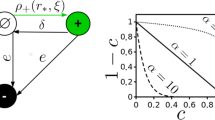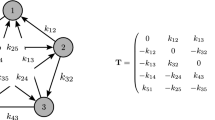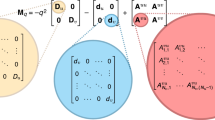Abstract
THE worldwide loss and fragmentation of natural habitats1has led to considerable theory on metapopulation dynamics2á¤-8. One modelling approach, using structured population models9,10, predicts that metapopulations in which local dynamics are affected by migration may have alternative stable equilibria11á¤-17. We have tested this prediction with extensive data on the butterfly Melitaea cinxia18,19. Here we show that the probability of local extinction decreases with increasing population size and increasing immigration rate, and that local populations tend to be larger in regions with higher density of extant populations19, results consistent with model assumptions and predictions13,17. Our results exhibit a bifurcation pattern indicating multiple equilibria14, with a strikingly bimodal distribution of the fraction of occupied habitat in 65 semi-independent patch networks. These results help to explain observations of species occupying either most, or very little, of the suitable habitat in well-connected patch networks14,20,21. Metapopulations with multiple equilibria may collapse unexpectedly to extinction even in landscapes degrading only slowly. Multiple equilibria make it difficult to predict the occurrence of species in fragmented landscapes.
This is a preview of subscription content, access via your institution
Access options
Subscribe to this journal
Receive 51 print issues and online access
$199.00 per year
only $3.90 per issue
Buy this article
- Purchase on Springer Link
- Instant access to full article PDF
Prices may be subject to local taxes which are calculated during checkout
Similar content being viewed by others
References
Morris, D. W. Nature 373, 25 (1995).
Gilpin, M. & Hanski. I. (eds) Metapopulation Dynamics: Empirical and Theoretical Investigations (Academic, London, 1991).
Hastings, A. & Higgins, K. Science 263, 1133–1136 (1994).
Tilman, D. et al. Nature 371, 65–66 (1994).
Hassell, M. P., Comins, H. N. & May, R. M. Nature 370, 290–292 (1994).
Durrett, R. & Levin, S. A. Phil. Trans. R. Soc. Lond. B 343, 329–350 (1994).
May, R. M. in Large-scale Ecology and Conservation Biology (eds Edwards, P. J., May, R. M. & Webb, N. R.) 1–18 (Blackwell Scientific, Oxford, 1994).
Kareiva, P. & Wennergren, U. Nature 373, 299–302 (1995).
Metz, J. A. J. & Diekmann, O. (eds) The Dynamics of Physiologically Structured Populations (Springer, Berlin, 1986).
Ebenman, B. & Persson, L. (eds) Size-structured Populations (Wadsworth, Belmont, CA, 1988).
Hastings, A. & Wolin, C. L. Ecology 70, 1261–1266 (1989).
Hastings, A. in Metapoputation Dynamics: Empirical and Theoretical Investigations (eds Gilpin, M. & Hanski, I.) 57–71 (Academic, London, 1991).
Gyllenberg, M. & Hanski, I. Theor. Populat. Biol. 42, 35–61 (1992).
Hanski, I. & Gyllenberg, M. Am. Nat. 142, 17–41 (1993).
Hastings, A. & Harrison, S. A. Rev. Ecol. Syst. 25, 167–188 (1994).
Hanski, I. Ecology 66, 335–343 (1985).
Hanski, I. & Zhang, D.-Y. J. Theor. Biol. 163, 491–504 (1993).
Hanski, I., Kuussaari, M. & Nieminen, M. Ecology 75, 747–762 (1994).
Hanski, I. et al. Oikos 72, 21–28 (1995).
Hanski, I. Oikos 38, 210–221 (1982).
Thomas, C. D. in Individuals, Populations and Patterns In Ecology (eds Leather, S., Watt, A. & Mills, N.) (Blackwell, Oxford) (in the press).
Diamond, J. M. in Extinctions (ed. Nitecki, M. H.) 191–246 (Univ. Chicago Press, 1984).
Schoener, T. E. & Spiller, D. A. Nature 330, 474–477 (1987).
Brown, J. H. & Kodric-Brown, A. Ecology 58, 445–449 (1977).
Whitlock, M. Am. Nat. 139, 952–970 (1992).
Sjögren Gulve, P. Ecology 75, 1357–1367 (1994).
Gotelli, N. J. & Simberloff, D. Am. Nat. 130, 18–35 (1987).
Pullin, A. S. (ed.) Ecology and Conservation of Butterflies (Chapman & Hall, London, 1995).
New, T. R. et al. A. Rev. Ent. 40, 57–83 (1995).
Hanski, I. et al. Conserv. Biol. (in the press).
Author information
Authors and Affiliations
Rights and permissions
About this article
Cite this article
Hanski, I., Pöyry, J., Pakkala, T. et al. Multiple equilibria in metapopulation dynamics. Nature 377, 618–621 (1995). https://doi.org/10.1038/377618a0
Received:
Accepted:
Issue Date:
DOI: https://doi.org/10.1038/377618a0
This article is cited by
-
Consequences of animal interactions on their dynamics: emergence of home ranges and territoriality
Movement Ecology (2014)
-
Phylogeography and population history of Leopardus guigna, the smallest American felid
Conservation Genetics (2014)
-
Relative importance of host plant patch geometry and habitat quality on the patterns of occupancy, extinction and density of the monophagous butterfly Iolana iolas
Oecologia (2008)
-
Determination of national conservation responsibilities for species conservation in regions with multiple political jurisdictions
Biodiversity and Conservation (2008)
-
Parasites promote host gene flow in a metapopulation
Evolutionary Ecology (2007)
Comments
By submitting a comment you agree to abide by our Terms and Community Guidelines. If you find something abusive or that does not comply with our terms or guidelines please flag it as inappropriate.



